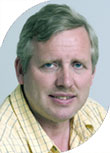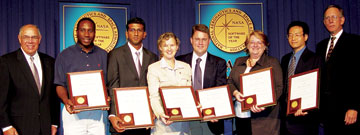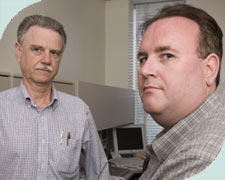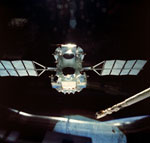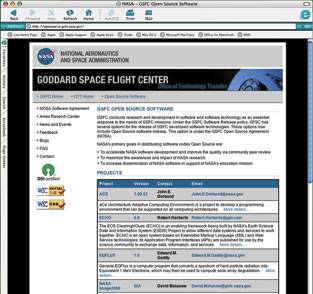|
||||||||||||||||||||||||||||||||||||||||||||||||||||||||||||||||||||||||||||||||||
 |
||||||||||||||||||||||||||||||||||||||||||||||||||||||||||||||||||||||||||||||||||
| volume 3, number 2 : summer 2005 |
[Download free Acrobat Reader] |
|||||||||||||||||||||||||||||||||||||||||||||||||||||||||||||||||||||||||||||||||
| Contents: researcher profile: tech transfer in action: agreements: software news: workshop: |
Goddard has entered into two agreements that grant NASA scientists access to cutting-edge nanotechnology research facilities outside the Agency. “These agreements essentially allow NASA to expand our infrastructure without incurring the costs of building the labs and buying the equipment ourselves,” said Dan Powell (Code 540), Goddard’s lead nanotechnology researcher. “And anyone at Goddard can take advantage of these arrangements.” Earlier this year, Goddard signed an agreement with the Army Research Laboratory (ARL) to develop a joint program of collaboration that enhances each lab’s research capabilities. Areas of collaboration include design, fabrication, and testing of nanoscience and microelectromechanical systems (MEMS) devices and technologies for use in chemical and biological detectors, power generation, thermal management systems, radio frequency electronics, electro-optic devices, and distributed sensor networks. Under the agreement ARL personnel will have access to Goddard’s Detector Development Laboratory, and Goddard personnel can access ARL’s Specialty Electronic Materials and Sensors Cleanroom. Lehigh’s JEOL TEM, which has 0.1-nm resolution, can be operated remotely. Powell is establishing an operation interface within Building 30 to provide real-time, remote access to Lehigh’s instrument. Once that interface is established, Goddard researchers have up to 100 hours of JEOL TEM time at no cost. This access allows NASA to begin to demonstrate the potential for space-based remote microscopy, which could be used in future missions. For more information about how to take advantage of these agreements, contact Dan Powell (6-0428) or Darryl Mitchell (6-5169) of the Innovative Partnerships Program Office.
|
|||||||||||||||||||||||||||||||||||||||||||||||||||||||||||||||||||||||||||||||||
|
awards
RHSEG provides a new approach to image analysis that increases accuracy for two-dimensional (and potentially three-dimensional) image analysis. Dr. Tilton began developing the software algorithm in 1983 for remote earth sensing. Because individual pixels do not necessarily provide enough information about where they fit into the overall “scene,” he thought about image segmentation and analyzing the data beyond the typical “per-pixel” approach. Dr. Tilton theorized that a better understanding could be achieved by considering the context of the image and looking at the objects in the image rather than the individual pixels. The RHSEG software offers unprecedented precision and control for image and image-like data analysis that can be applied to an extremely broad range of applications, including medical imaging, drug development, data mining, facial recognition, and thermal imaging. Improvements in these areas, particularly medical diagnosis, have far-reaching effects for everyday life. Online information is available on the RHSEG technology and IS&T Award.
Goddard-Led Team Wins NASA’s Software of the Year Award
A team of researchers led by Christa Peters-Lidard (Code 614.3) and Paul R. Houser (George Mason University) is a co-winner of the NASA 2005 Software of the Year Award for the Land Information System (LIS) software. The team includes James V. Geiger, Jr. (Code 587), Susan P. Olden (Code 586), and Luther Lighty (Code 587) as well as Sujay V. Kumar and Yudong Tian (University of Maryland–Baltimore County). A high-performance modeling and data assimilation system, LIS performs local, regional, and global land surface simulations. The software helps enable accurate prediction of water and energy cycles, providing information for water-resource management, weather prediction, air-quality monitoring, and military operations. LIS is being used in major areas of NASA mission support and is employed by other U.S. agencies. “This award is a very exciting validation that NASA sees huge potential for LIS both within its own research walls and beyond—in both the larger scientific community and in applications with other agencies and commercial partners,” said Dr. Peters-Lidard. Released as an open-source project (see article below), LIS provides great potential for commercial uses such as weather and hazard-related information and services. To apply for this and other NASA awards, innovators must complete a New Technology Report (NTR) via the eNTRe system and a Space Act Award Application, which can be downloaded from the NASA Inventions and Contributions Board Web site. For more information, contact OTT’s Dale Hithon (6-2691). |
||||||||||||||||||||||||||||||||||||||||||||||||||||||||||||||||||||||||||||||||||
|
Tell us about your work with IPP. What have you been doing? How have you benefited from this work? Any advice for your colleagues? |
||||||||||||||||||||||||||||||||||||||||||||||||||||||||||||||||||||||||||||||||||
Tech Transfer in Action SpaceWire: Revolutionizing Hardware Development Developed in 1999 by a group working under the auspices of the European Space Agency, the SpaceWire standard defines a network of nodes and routers interconnected through bidirectional high-speed serial links. Previously no high-speed bus standard existed for space-flight hardware, resulting in custom-built designs developed on a by-project basis, which led to long development times with high costs and risks. SpaceWire has revolutionized space-flight hardware development by defining a standard architecture for payload data systems and specifying the physical interconnections and communication protocols to enable the reliable sending of data at high speeds. “SpaceWire lets you create one design that you can go to every time, for every mission,” said Glenn Rakow (Code 561), who served as an adviser to the SpaceWire working group. “The more people we get using it, the more ideas we’ll have.” Since the SpaceWire protocol was introduced, Rakow has played a leading role in its proliferation in the United States. “His innovative development of SpaceWire capabilities and expertise at NASA Goddard has established us as the internationally recognized expert in the development and delivery of products and features to support Earth and space science missions,” said Goddard’s Mark Voyton (Code 561), command and data handling systems manager for JWST. In addition to presenting SpaceWire and its benefits to many NASA projects and U.S. companies, Mr. Rakow has developed several technologies based on the SpaceWire standard, and these inventions are serving as the seed from which SpaceWire-based hardware can grow. By working closely with Goddard’s Innovative Partnerships Program Office, Mr. Rakow has been able to provide his SpaceWire technologies to the U.S. Department of Defense and nearly a dozen aerospace companies (see article below for a single example). “The IPP is key to making sure the technology is transferred in a consistent, uniform way so that no one gets an unfair advantage,” explained Mr. Rakow. “The rules and restrictions for tech transfer to industry are so complex, it would be difficult if not impossible for me to keep up with all of that and still maintain my technical edge.” The signing of Space Act Agreements (SAAs) also allows for assistance to be provided to industry under full-cost accounting. “The landscape has really changed,” noted Mr. Rakow. “My contractors and I couldn’t spend the time working with these industry partners without the SAA in place.” |
||||||||||||||||||||||||||||||||||||||||||||||||||||||||||||||||||||||||||||||||||
|
Agreements
Assisting Industry while Giving Long-Term Benefits to NASA Two recently signed agreements are providing private companies with Goddard expertise to help them address their technical challenges. In the short term, NASA will be reimbursed for its researchers’ time. In the years to come, it is expected that the results of this joint research will come back to NASA to further benefit the space program.
researcher: James Tilton (Code 606.3) Dr. Tilton will be working with Bartron to develop a three-dimensional (3-D) version of his RHSEG software. This image analysis program currently offers selectable levels of detail to increase accuracy for 2-D images, and Bartron uses RHSEG in its Med-Seg™ medical imaging device. By extending the software’s capabilities to three dimensions, Bartron’s device may be able to produce a much finer detail view of all sides of a tumor or lesion, drastically improving very early diagnosis and treatment of disease. “Since a primary application of this technology is for medical imaging, it is reasonable to expect that NASA may also be able to use this technology aboard the International Space Station or in support of the NASA Exploration Initiative for Moon/Mars exploration and/or colonies,” said OTT’s Joe Famiglietti. Go to RHSEG for more information about this technology.
researcher: Glenn Rakow (Code 561) Continuing his extensive efforts to gain U.S. industry acceptance of the new SpaceWire standard (see article above), Mr. Rakow will be working cooperatively with a leading U.S. aerospace corporation to transfer his SpaceWire-based technology and to assist the company in modifying that technology to support its own space-flight missions. These modifications eventually will be made available to NASA. The SpaceWire standard is a high-speed communications protocol for flight electronics that is flexible, modular, and reusable. Establishing SpaceWire as the space-flight networking standard will help to save both industry and NASA development time and resources for future missions. |
||||||||||||||||||||||||||||||||||||||||||||||||||||||||||||||||||||||||||||||||||
|
“Open Source” Web Site Boosts Use of Goddard Software
In September 2004, the Innovative Partnerships Program Office created the Open Source Web site, making available the source code for various software programs developed at Goddard. Since then, the site has served as the launch pad for several programs designed by Goddard innovators. The primary goals of the Open Source Web site are:
In keeping with these goals, anyone can access this site and download the programs for their own use without having to sign any paperwork. As explained by Bryan Geurts of Goddard’s Office of Patent Counsel, “Simply downloading and using the software binds the recipient to the terms of the NASA Open Source Agreement (NOSA).” Developed jointly by patent counsel at several NASA centers, including Goddard, Ames, and Langley, the NOSA has been ratified by the Open Source Initiative (OSI) and added to the official list of certified licenses. “Getting the NOSA certified by OSI was a real accomplishment,” said Mr. Geurts. “It put NASA as the first government agency to obtain such certification. Now the NOSA is serving as a model for other federal agencies seeking to make their software available through open source.” The site is updated as new downloadable code and new versions of previous programs become available. Some programs, like Alan Cudmore’s (Code 582) Operating System Abstraction Layer (OSAL) 2.0, are featured on LinuxDevices.com, which has increased traffic at Goddard’s site. “This has allowed me to share my project with other NASA centers, industry partners, commercial vendors, and academic institutions” said Mr. Cudmore. “Since my software was released as open source, I have received positive feedback, bug reports, and interest in potential collaborations. In the long run, I believe it will increase our productivity and raise the awareness of the work we do at Goddard.” For information about how to get software programs posted on the Goddard Open Source Web site, contact Dele Young (6-7958). |
||||||||||||||||||||||||||||||||||||||||||||||||||||||||||||||||||||||||||||||||||
Workshop Leading Innovation Strategist to Speak at Workshop On September 23, Goddard researchers will have the opportunity to learn from one of the authors of the highly acclaimed book The Innovator’s Solution, which has been named on several top 10 lists and as the “Best Strategy Book of the Year” by Booz Allen Hamilton. Michael Raynor will be the featured speaker at the fourth Technology Transfer Investment Workshop, a series designed to help researchers participate in the forming of high-impact partnerships. Drawing on years of in-depth research and using new theories tested in hundreds of companies across many industries, Raynor (a professor as well as strategic thinker with Deloitte Research) and Harvard Business School professor Clayton M. Christensen have identified the processes that create successful innovations. Innovators will benefit from the authors’ insights in a program specifically tailored for NASA researchers. At the workshop, Mr. Raynor will be discussing:
For more information, go to Investment Workshop or contact Kate Littlefield (6-7609)
NIST: National Institute of Standards and Technology |
||||||||||||||||||||||||||||||||||||||||||||||||||||||||||||||||||||||||||||||||||
|
New technologies reported: 37 New technologies were reported by the following civil servants, contractors, and universities:
|
||||||||||||||||||||||||||||||||||||||||||||||||||||||||||||||||||||||||||||||||||
|
We want to do all we can to make it easy and rewarding for you to participate in technology transfer. But we need your help. Send us your ideas for program improvements or News articles via e-mail. |
||||||||||||||||||||||||||||||||||||||||||||||||||||||||||||||||||||||||||||||||||
|
You can report new project technologies through the online eNTRe system. |
||||||||||||||||||||||||||||||||||||||||||||||||||||||||||||||||||||||||||||||||||
|
Innovative Partnerships Program Office |
||||||||||||||||||||||||||||||||||||||||||||||||||||||||||||||||||||||||||||||||||
|
||||||||||||||||||||||||||||||||||||||||||||||||||||||||||||||||||||||||||||||||||

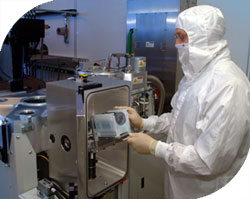
.jpg)
